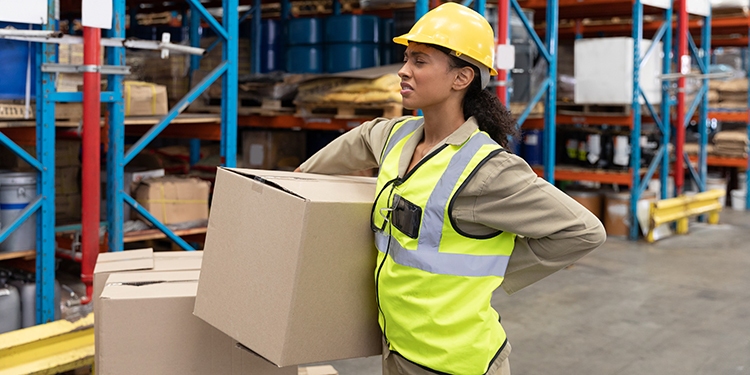Lower The Chance Of Back Injuries With Ergonomic Solutions

This post is part of the EASE Educational Series: Ergonomic Solutions from Head to Toe
In 2019, 4,790 workers employed in the general warehousing and storage industry experienced a back injury that kept them off the job for multiple days, according to the Bureau of Labor Statistics’ most recent report on nonfatal injuries and illnesses. Further, another 4,090 back injuries were reported among refrigerated warehousing and storage employees in the same year. Indeed, the National Institute of Occupational Safety and Health (NIOSH) has noted that warehouse workers are at least eight times more likely to sustain back injuries compared to workers in other fields. All those back problems — both upper and lower — add up to an average total in excess of $33,000 and $36,000 respectively in workers’ compensation costs per injury, as documented by the National Safety Council.
Back injuries in the warehouse are most often caused by improper lifting technique, as well as repetitive lifting, pulling, or pushing a heavy object. Additionally, jobs that require reaching or twisting to obtain or move items can contribute to back injuries. Fortunately, the chance of a worker sustaining a back injury while on the job can be significantly reduced by implementing comprehensive training programs along with task-specific ergonomic assist equipment. These devices help personnel perform tasks safely and with minimal physical exertion. These solutions include:
Lift-and-Tilt Tables: One approach to reducing the risk of a worker sustaining a back injury is to utilize solutions that keep parts at an optimal level for the work while reducing the need to reach for packaging materials and related components. For example, in manual pick-and-place processes that involve repeatedly reaching for, picking up, and lifting items out of a container or off a pallet, a floor-based load tilter can accommodate all shapes and sizes of both products and workers. Powered mechanically, pneumatically or hydraulically, an industrial tilter lifts and tilts a load, raising the contents of a container to the optimal height and angle for an associate to reach in and pick the item. The tilting function, controlled by the worker, allows the container to tip toward him or her at a range of pitch angles (attitudes). By bringing the items closer to the body, bending, stretching and reaching is minimized, as is the likelihood of a back injury.
Carts with Low Rolling Resistance: In small- to medium-sized warehouses and manufacturing operations especially, manual movement of parts and components via carts is often a key aspect of the process. Many of today’s carts are designed to significantly reduce the push/pull forces required for starting or stopping forward motion by utilizing specially constructed wheels and casters and specific placement of those components, different construction materials, and accessories. This in turn reduces worker back strain associated with maneuvering a loaded cart.
Height-Adjustable Workstations: Ergonomic workstations are designed to maximize associates’ productivity while minimizing their risk of injury, with many incorporating the ability to easily raise and lower the surface height (with a push-button activated motor or manual crank) to accommodate different sized workers. The adjustability allows the same workstation to be used for multiple shifts and by multiple personnel. It also enables each worker using the station to move in a more natural manner. Workstations are specifically designed with the task in mind to ensure that all activities that might result in back strain (bending, lifting, reaching) are minimized with the use of specific accessories positioned in the optimal reach zone.
Looking for more ways to improve ergonomics in your manual material handling operation? Download the free publication, “Ergonomic Guidelines for Manual Material Handling,” published by the members of MHI’s Ergonomic Assist Systems & Equipment (EASE) Industry Group.



